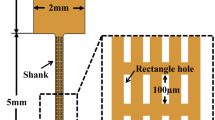Abstract
Compared with stiff silicon-based probes, flexible neural probes can alleviate biological inflammation and tissue rejection. A polyethylene glycol (PEG) coating can facilitate the insertion of flexible probes, and the fabrication methods have a significant impact on the dimensional accuracy and structural strength of the coating. In this study, a novel melting injection moulding method is used to process a PEG-dexamethasone (PEG-DEX) coating with high structural strength for a type of mesh-shaped photosensitive polyimide (PSPI) based neural probe. Combined with the digital image correlation (DIC) method, an in vitro test system with high accuracy is developed to evaluate the effects of the elastic modulus of the PEG component and two fabrication methods, i.e., computer-numerical-control (CNC) micro-milling and laser engraving, on the processing quality and implantation mechanics of a PEG-DEX coated probe. The results show that compared with laser engraving, CNC micro-milling can ensure high dimensional accuracy and sharpness for the composite coating, thus leading to small damage from implantation, whereas the elastic modulus of the composite coating has a limited effect on the implantation mechanics of the PEG-DEX coated probe.
Similar content being viewed by others
References
DONOGHUE J P. Bridging the brain to the world: A perspective on neural interface systems [J]. Neuron, 2008, 60(3): 511–521.
KOZAI T D Y, JAQUINS-GERSTL A S, VAZQUEZ A L, et al. Brain tissue responses to neural implants impact signal sensitivity and intervention strategies [J]. ACS Chemical Neuroscience, 2015, 6(1): 48–67.
LECOMTE A, DESCAMPS E, BERGAUD C. A review on mechanical considerations for chronically-implanted neural probes [J]. Journal of Neural Engineering, 2018, 15: 031001.
ZHOU T, HONG G S, FU T M, et al. Syringe-injectable mesh electronics integrate seamlessly with minimal chronic immune response in the brain [J]. Proceedings of the National Academy of Sciences of the United States of America, 2017, 114(23): 5894–5899.
ORTIGOZA-DIAZ J, SCHOLTEN K, LARSON C, et al. Techniques and considerations in the microfabrication of Parylene C microelectromechanical systems [J]. Micromachines, 2018, 9(9): 422.
CEYSSENS F, WELKENHUYSEN M, PUERS R. Anisotropic etching in (3 1 1) Si to fabricate sharp resorbable polymer microneedles carrying neural electrode arrays [J]. Journal of Micromechanics and Microengineering, 2019, 29: 027001.
LECOMTE A, CASTAGNOLA V, DESCAMPS E, et al. Silk and PEG as means to stiffen a parylene probe for insertion in the brain: Toward a double time-scale tool for local drug delivery [J]. Journal of Micromechanics and Microengineering, 2015, 25: 125003.
WELTMAN A, YOO J, MENG E. Flexible, penetrating brain probes enabled by advances in polymer microfabrication [J]. Micromachines, 2016, 7(10): 180.
XIANG Z L, YEN S C, XUE N, et al. Ultra-thin flexible polyimide neural probe embedded in a dissolvable maltose-coated microneedle [J]. Journal of Micromechanics and Microengineering, 2014, 24(6): 065015.
TIEN L W, WU F, TANG-SCHOMER M D, et al. Silk as a multifunctional biomaterial substrate for reduced glial scarring around brain-penetrating electrodes [J]. Advanced Functional Materials, 2013, 23(25): 3185–3193.
BEDIZ B, KORKMAZ E, KHILWANI R, et al. Dissolvable microneedle arrays for intradermal delivery of biologics: Fabrication and application [J]. Pharmaceutical Research, 2014, 31(1): 117–135.
TAKMAKOV P, RUDA K, PHILLIPS S K, et al. Rapid evaluation of the durability of cortical neural implants using accelerated aging with reactive oxygen species [J]. Journal of Neural Engineering, 2015, 12(2): 026003.
MESA-MÚNERA E, RAMÍREZ-SALAZAR J F, BOULANGER P, et al. Inverse-FEM characterization of a brain tissue phantom to simulate compression and indentation [J]. Ingeniería y Ciencia, 2012, 8(16): 11–36.
TANG J Q, ZHANG W G, CAI F L, et al. A comparative study on tissue injury caused by implantation based on electrode with the capability of micro-motion attenuation [J]. Journal of Shanghai Jiao Tong University, 2018, 52(2): 188–193 (in Chinese).
ZHANG W G, MA Y K, LI Z W. Experimental evaluation of neural probe’s insertion induced injury based on digital image correlation method [J]. Medical Physics, 2016, 43(1): 505–512.
ZHANG W G, TANG J Q, LI Z W, et al. A novel neural electrode with micro-motion-attenuation capability based on compliant mechanisms: Physical design concepts and evaluations [J]. Medical & Biological Engineering & Computing, 2018, 56(10): 1911–1923.
JEE A Y, LEE H, LEE Y, et al. Determination of the elastic modulus of poly(ethylene oxide) using a photoisomerizing dye [J]. Chemical Physics, 2013, 422: 246–250.
LEE H C, EJSERHOLM F, GAIRE J, et al. Histological evaluation of flexible neural implants; flexibility limit for reducing the tissue response? [J]. Journal of Neural Engineering, 2017, 14(3): 036026.
Acknowledgement
The authors would like to thank the technical support from the Instrumental Analysis Center of Shanghai Jiao Tong University.
Author information
Authors and Affiliations
Corresponding author
Additional information
Foundation item
the National Natural Science Foundation of China (No. 51675330)
Rights and permissions
About this article
Cite this article
Zhou, X., Zhang, W. & Xie, J. Effects of Micro-Milling and Laser Engraving on Processing Quality and Implantation Mechanics of PEG-Dexamethasone Coated Neural Probe. J. Shanghai Jiaotong Univ. (Sci.) 26, 1–9 (2021). https://doi.org/10.1007/s12204-020-2243-7
Received:
Accepted:
Published:
Issue Date:
DOI: https://doi.org/10.1007/s12204-020-2243-7
Key words
- flexible neural probe
- composite coating
- digital image correlation (DIC)
- polyethylene glycol (PEG)
- dexamethasone (DEX)
- insertion force
- implantation injury




